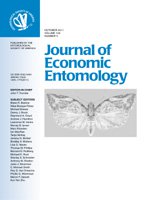The spatial association pattern of insect and mite populations in a steel bin containing stored wheat, Triticum durum Desf., in central Greece, was studied using the Spatial Analysis by Distance IndicEs (SADIE). The monitoring was carried out for 7 mo by using grain trier samples and probe traps. The most abundant insect species were Cryptolestes ferrugineus (Stephens) (Coleoptera: Laemophloeidae) and Plodia interpunctella (Hübner) (Lepidoptera: Pyralidae). For mites, the most abundant species were the phytophagous Lepidoglyphus destructor (Schrank) (Acari: Glycyphagidae) and the predator Blattisocius tarsalis (Berlese) (Mesostigmata: Ascidae). Both for P. interpunctella and C. ferrugineus, trap catches were associated with numbers of individuals in the trier samples, but the overall association index calculated among trap and sample counts was significant only in the 33% of trap-sample pairs of values. Generally, P. interpunctella had the main patch areas in the central part of the bin, with few exceptions, during the entire monitoring period. Similar trends also were noted in the case of C. ferrugineus, which was clearly aggregated in the center of the grain mass. Spatial association maps indicated a stable positive association in the central part of the bin, but in most of the other sampling zones the association was negative. However, distribution of L. destructor, based on trier samples, indicated increased presence in peripheral zones of the grain sampling area. Moreover, B. tarsalis presented the most dispersed distribution among all four species. For each species, the association between two consecutive samplings was significant in the majority of cases, indicating a stable spatial pattern. Finally, B. tarsalis was spatially associated to a higher degree with the insects found rather than with L. desctructor. Moreover, there was no association of insect and mite presence with grain temperature and moisture content. The results of the current study suggest that the coexistence of insects and mites in bulked grain follows a complex pattern, with significant interactions, especially in the case of mite predators, which are spatially associated with insect species.
How to translate text using browser tools
1 October 2011
Spatial Associations of Insects and Mites in Stored Wheat
Christos G. Athanassiou,
Nickolas G. Kavallieratos,
Andrea Sciarretta,
Nickolas E. Palyvos,
Pasquale Trematerra
ACCESS THE FULL ARTICLE
It is not available for individual sale.
This article is only available to subscribers.
It is not available for individual sale.
It is not available for individual sale.

Journal of Economic Entomology
Vol. 104 • No. 5
October 2011
Vol. 104 • No. 5
October 2011
Blattisocius tarsalis
Cryptolestes ferrugineus
Lepidoglyphus destructor
Plodia interpunctella
SADIE




